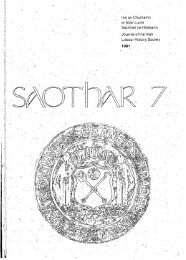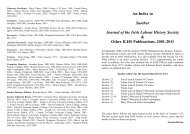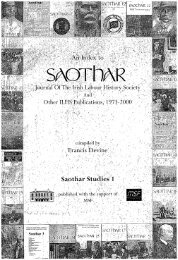14 SAOTHAR13month and year that the abolition committee thought it had won its victory, in August, 1855. 52 ThePolice Commissioners believed they had wrought a social and moral revolution of which theDonnybrook saga was only one episode. That the common people should resort to enjoying themselvesin any large numbers had been a constant source of anxiety to the police authori ties apart altogether fromthe Donnybrook affair. From the earliest part of the century they had been kept under surveillance. Thepolice spy, Luke Brien, for example, in March, 1805, reported to the celebrated police officer MajorSirr that, in accordance with Sirr's orders, he had attended 'the football and wrestling match held in afield near the circular road, the top of Stony batter'. There he found 1,000 spectators, mainly workmenof the breweries, distilleries, bakeries and dairies of the area. After the football and a half hour of thewrestling match a Justice of the Peace came with a force and dispersed them.53In the ye~ before this some fifty men were taken prisoner following a football and wrestling matchin Rathmines. According to police magistrate J. Townsend, in his report to the Castle authorities, thismeeting was similar in nature to those 'often held at Donnybrook before the late insurrection, forhurling, but the parties in the present instant were wrestling and football playing'.54 He described howinformation about these matches circulated by word of mouth 'among the common workmen in themarkets, distilleries and breweries'. In the case of this meeting at Rathmines he believed the majorityof those arrested were 'mere spectators' who 'may really have been innocent'. Then, in a classic ofthelanguage of social control, he added that 'the mere apprehension and detention of some of the spectatorsfor a night may have good effects', and that 'their curiosity should be discouraged'.The grave dangers inherent in popular football and wrestling matches held on the outskirts of Dublincontinued to concern the authorities as the century wore on. In February 1845 constable Francis Scottof Stepaside Police Station reported on the wrestling matches held weekly at Leopardstown. Apparentlythe wrestlers and spectators travelled there each Sunday from as far afield as Bray and Kingstownto the south, and Howth and Baldoyle to the north. He believed their recreation would lead to a breachof the peace. His information was supported two days later in a deposition from fellow constableMichael Lyons who claimed a local blacksmith, Pat Con nor , a farm servant named Kelly, and one J amesSullivan of Sandyford told him they had 'come to wrestle with the mountain men'. Forwarding thesereports to Dublin Castle the local magistrate, Burgh Crofton of Roebuck Castle, requested a constabularyreinforcement of thirty men to keep control. 55Between the surveillance of popular recreations and rough sports by police informants in the early1800s, through the harrying and arrest of Dublin street balladeers like poor old Zozimus in the 1840sto the ultimately successful campaign against Donnybrook Fair in the 1850s and 1860s, the Dublinpolice claimed credit for a minor revolution. With the radical reform of policing through the comingof the DMP in 1838 - a body run with ruthless efficiency56 - there was a transformation of the social lifeof lower class Dublin, according to the police themselves. In an internal memorandum of 1857, twoinspectors who had served on the old force and who had survived to be promoted to the new, describedthe old force as one where some members were crippled or nearly blind and where others drank withthieves and prostitutes. They claimed that in those days Dublin's public houses never closed but 'werefurnished with relays of waiters' , and that 'the practice of stripping and fighting in a state of nudity inthe public streets (especially on Sabbath mornings)' was widespread. The ultimate degradation was that'the suburbs such as Ringsend, lrishtown, Harold's Cross, Phibsboro', Dolphin's Barn and Phoenix Parkon Sunday mornings were the scenes of the most disgraceful and disgusting proceedings, viz., wrestling,dog fighting, cockfighting, boxing, gambling and drinking in the open air. '57But twenty years later all this had changed, and the change was due, according to SuperintendentMonaghan, 'mainly, if not exclusively, to the operation of the police' .58 Such a claim to the main creditwas surely a bit much; but Monaghan was prepared to concede that 'the people of the working andindustrious classes are (now) much more amenable to the law', and he admitted that this may have beendue also, in some measUre, to 'educational influences' , and that the' calamities of the famine years may
<strong>THE</strong> DECLINE AND FALL <strong>OF</strong> DONNYBROOK FAIR 15have operated chasteningly, therefore beneficially upon the temper of the people'. He concluded hisassessment of the "moral revolution by admitting that' doubtless other ameliorating agencies may havebeen at work', without however specifying them.Quite clearly one of these unspecified forces or influences acting as a major agency in the moralreform that chastened the common people and abolished popular resorts and recreations like DonnybrookFair was that of religion. It was, after all, the Sabbatarians' sense of decency affronted andSundays desecrated that led Lord MayorRichard Smythin the 1820s and Lord Mayor WiIliam Hodgesin the 1830s to take the first practical steps to ~hallenge the traditions of Donnybrook Fair. Likewiseit was the resurgent Roman Catholic Churctijn thy persons of the ,Rev. P.J. Nowlan, Dr. John SprattandCardinal Paul Cullen who orgariised the final moral assault on the pleasures of Donnybrook Fair. Sprattwas a splendid example of the zeal for moral reform. He spent his life in Dublin working for the reliefof its poor, the protection of.animals and in the attack on drink. He was involved in the cause oftemperance even before his friend Fr. Mathew became a celebrity.59 Donnybrook Fair fell victim toa religious reformation and a temperance crusade just as much asit did to police desire for social controlof the populace. Donnybrook Fair was not the only victim of clerical zeal for the moral improvementof the masses. Beyond the northern boundaries of the city the village of Finglas had for long held"a MayFair on its green, and its May Queen was chosen in a ceremony 'celebrated with great pomp', but inthe early 1840s the new curate of Finglas parish, Fr. Young, put an end to the ancient popular festivitiesand saw to the cutting down of the May pole on the village green. 60The crusade for the moral reform of Donnybrook was not exclusively the product of a resurgentRoman Catholicism: rather it was an assault based on an alliance of the most zealous eiements inevangelical Protestantism working with the forces of militant Catholicism. This was ironic in a citywhich still exhibited an extreme, if normally covert, sectarianisrri. C~ltholics and Protestants, howeverprofessional, educated or respectable, entertained deep mutual hostility.61 Nevertheless, these deeplyheld mutual suspicions and animosities were quietly put aside between 1835 and 1866 in the religiousalliance to save the common people from the sinful pleasures of Donnybrook Fair.The ~lliance did not endure and in 1865 had a very remarkable denouement indeed. The newCatholic Church of the Sacred Heart had cost more than its originators had intended. In order to lessenthe outstanding debts the fund-raising committee decided to organise a lottery or raffle. The prize fundwas impressive, listing 450 separate items. First prize was a six-roomed cottage on DaIkey Hill, rentfree for ever. The draw was to take place at the Rotunda in Dublin on 16 October, 1865. Some ofDublin's Protestants took exception to this lottery and contacted Charles Bird, secretary of theProtestant Alliance in London. In turn he wrote to Thomas Mostyn, Crown Solicitor in Dublin Castle,on 8 September, 1865. He enclosed a sixpenny lottery ticket for this Catholic undertaking and hoped'measures will be taken to stop the drawing which is illegal'. He pointed out that Mostyn had stoppeda similar 'illegal and demoralising practice' in Ireland in 1860. 62 Mostyn wasted no time in sendingBird's letter and the lottery ticket to the Undersecretary, and begged to know 'if it is the desire of thegovernment that I take any steps'. Promptly caine the reply: 'no steps to be taken' .63First the police, and now the Catholic Church had been in breach of the law in association withattempts to extirpate the moral plague of Donnybrook. Although the Church could have found itselfin conflict with the secular authorities it is indicati ve of the growing power of the Church and significantof the government's sensitivity to this that the authorities acquieSCed in the Church's breach of the law.This, one must add, was no flash in the pan. There are other examples in the'1850s and 1860s of theCatholic Church in breach of law or customary rights in trying to prevent the holding of markets andfairs on Church holy days and where, despite protests, the state turned a blind eye. 64 Such examplesdemonstrate the growing moral power of the Catholic Church and make clear its moral contribution tothe qecline and fall of Donnybrook Fair and of other popular amusements of which it disapproved. Yet,that Church cannot be isolated from the society of which it was a part. Earlier in the century JonahBarrington spoke of,
- Page 1 and 2: JOURNAL OF THE IRISH LABOUR HISTORY
- Page 3 and 4: ContentsPageEditorial: Labour Histo
- Page 5 and 6: EDITORIAL 3freedom to participate i
- Page 7 and 8: CorrespondenceThe Irish Labour Part
- Page 9 and 10: ; ~ ; ,The Decline and Fall of Donn
- Page 11 and 12: THE DECLINE AND FALL OF DONNYBROOK
- Page 13 and 14: THE DECLINE AND FALL OF DONNYBROOK
- Page 15: ·' THE DECLINE AND FALL OF DONNYBR
- Page 19 and 20: THE DECLINE AND FALL OF DONNYBROOK
- Page 21 and 22: THE DECLINE AND FALL OF DONNYBROOK
- Page 23 and 24: THE DECLINE AND FALL OF DONNYBROOK
- Page 25 and 26: ,'-,;-''''.A PASSAGE TO BRITAIN 23C
- Page 27 and 28: A PASSAGE TO BRITAIN 25only in the
- Page 29 and 30: A PASSAGE TO BRITAIN 27clothing._De
- Page 31 and 32: A PASSAGE TO BRITAIN 29established
- Page 33 and 34: ;:-.",.- .. .", ...... '.:. '
- Page 35 and 36: LOUIE BENNETI 33feminist movement w
- Page 37 and 38: :... ~: ."
- Page 39 and 40: -.- '.LOUlE BENNETT 37While there i
- Page 41 and 42: LOUIE ~ENNEIT 39Xl's encyclical Qua
- Page 43 and 44: LOUIE BENNEIT 41Bennett's own relat
- Page 45 and 46: LODIE BENNETT 43109; IWWU resolutio
- Page 47 and 48: Essays in ReviewCosherers, Wanderer
- Page 49 and 50: ••• .".'. >. '~"ESSA YS IN RE
- Page 51 and 52: ESSAYS IN REVIEW 49ConnolIy:Myth an
- Page 53 and 54: ESSAYS IN ~EVIEW 51tion' in the Int
- Page 55 and 56: ESSAYS IN REVIEW53International:'I
- Page 57 and 58: REVIEWScontroversy is real history.
- Page 59 and 60: REVIEWSJoe Monks was among the earl
- Page 61 and 62: REVIEWSnolly-Column Song','Proudly
- Page 63 and 64: REVIEWSresulting from the arrival o
- Page 65 and 66: REVIEWS,63the book by means of an a
- Page 67 and 68:
REVIEWSlogue, it is hardly surprisi
- Page 69 and 70:
The Team For All Workers ...CULIAIB
- Page 71 and 72:
ESSAYS 69mission and moral refonn.l
- Page 73 and 74:
.. ...... ~.~ -~ .'- '.ESSAYS. 71fr
- Page 75 and 76:
ESSAYS 73claimed authority but whic
- Page 77 and 78:
ESSAYS 75provided the basis for soc
- Page 79 and 80:
ESSAYS 779. For comparisons see E.T
- Page 81 and 82:
ESSAYS 7952. Annals of Christ Churc
- Page 83 and 84:
ESSAYS' 81Fianna Fail and the Worki
- Page 85 and 86:
ESSAYS 83Eireann in 1925 visibly di
- Page 87 and 88:
ESSAYS 85recognition of the impract
- Page 89 and 90:
ESSAYS 871970, it created the condi
- Page 91 and 92:
ESSAYS89The Irish Immigrants' Contr
- Page 93 and 94:
ESSAYS" 91Although anti -Catholic p
- Page 95 and 96:
ESSAYS 93McCowie played a key role
- Page 97 and 98:
:. -,,'.' ',. .~.,:.ESSAYS 95Althou
- Page 99 and 100:
ESSAYS 97young girl of their own ba
- Page 101 and 102:
SourcesIrish Labour History Society
- Page 103 and 104:
SOURCES 101INovember, 1971 to no. 1
- Page 105 and 106:
SOURCES 103would claim credit for t
- Page 107 and 108:
SOURCES105Sources for Irish Labour
- Page 109 and 110:
SOURCES 107NorthWest Archives and L
- Page 111 and 112:
SOURCES 109In 1966 the Finnish gove
- Page 113 and 114:
TURNINGANEWLEAFThe CPSSUis the larg
- Page 115 and 116:
REMINISCENCE 113us due to my politi
- Page 117 and 118:
REMINISCENCE 115when Jim was presen
- Page 119 and 120:
REMINISCENCE 117of Dail Eireann. 17
- Page 121 and 122:
REMINISCENCE 119NotesThe above arti
- Page 123 and 124:
DOCUMENT STUDY 121James Connolly in
- Page 125 and 126:
DOCUMENT STUDY123SOCIAL DEMOCRATIC
- Page 127 and 128:
DOCUMENT STUDY 125proletariat of th
- Page 129 and 130:
DOCUMENT STUDY 127the support of Je
- Page 131 and 132:
DOCUMENT STUDY 12926. The Workers'
- Page 133 and 134:
131BibliographyA Bibliography of Ir
- Page 135 and 136:
BIBLIOGRAPHY 133Compton, P.A. Demog
- Page 137 and 138:
BIBLIOGRAPHY 135Levine, I. and Madd
- Page 139 and 140:
BIBLIOGRAPHY 137Turner, M. 'Towards
- Page 141 and 142:
BIBLIOGRAPHY 1394. Land and Agricul
- Page 143 and 144:
BIBLIOGRAPHY 141Clogher Record12 (2
- Page 145 and 146:
BIBLIOGRAPHY 143Political Research
- Page 147 and 148:
BIBLIOGRAPHY 145Pres, 1987.O'Brien,
- Page 149 and 150:
147Notes on Contributorsf onathanBe
- Page 151 and 152:
1901: Ireland's first general union
- Page 153 and 154:
ELECTRICAL TRADES UNION .Establishe





